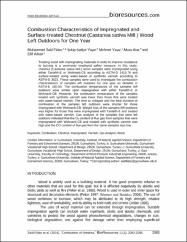Combustion Characteristics of Impregnated and Surface-treated Chestnut (Castanea sativa Mill.) Wood Left Outdoors for One Year
Erişim
Attribution 3.0 United Statesinfo:eu-repo/semantics/closedAccesshttp://creativecommons.org/licenses/by/3.0/us/Tarih
2016Erişim
Attribution 3.0 United Statesinfo:eu-repo/semantics/closedAccesshttp://creativecommons.org/licenses/by/3.0/us/Üst veri
Tüm öğe kaydını gösterÖzet
Treating wood with impregnating materials in order to improve resistance to burning is a commonly employed safety measure. In this study, chestnut (Castanea sativa Mill.) wood samples were impregnated using either Tanalith-E or Wolmanit-CB according to ASTM-D 1413-76 and surface-treated using water-based or synthetic varnish according to ASTM-D 3023. These samples were used to investigate the combustion characteristics of samples left outdoors for one year as detailed in ASTM-E 160-50. The combustion temperatures of the samples left outdoors were similar upon impregnation with either Tanalith-E or Wolmanit-CB. However, the combustion temperature of the samples treated with synthetic varnish was lower than those that were treated with water-based varnish. The time to collapse and the total duration of combustion of the samples left outdoors were shorter for those impregnated with Wolmanit-CB. Weight loss of the samples left outdoors was higher for those that were impregnated with Tanalith-E and treated with water-based varnish. Gas analysis of the samples that were left outdoors indicated that the O-2 content of flue gas from samples that were impregnated with Wolmanit-CB and treated with synthetic varnish was high and the CO content of flue gas from the same samples was low.
Cilt
11Sayı
1Koleksiyonlar
Aşağıdaki lisans dosyası bu öğe ile ilişkilidir:



















